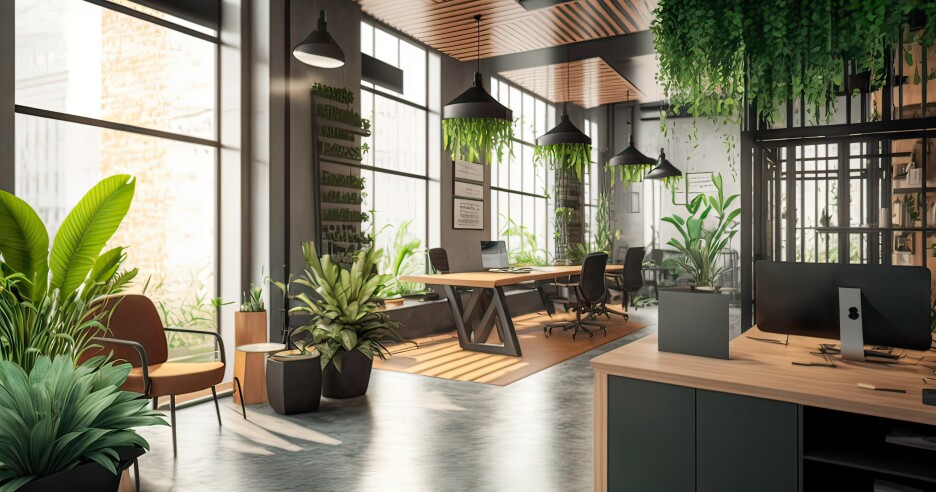Share:
Biophilic Design in the Workplace
The benefits of nature is something that’s drummed into us constantly. Get outside, breathe in the fresh air, have a walk outdoors everyday for your mental health. But of course, it’s in no way a new phenomenon. The popularity of groups participating in the ancient Japanese practise of forest bathing (known as Shinrin Yoku) is growing nationwide. The practise focuses on the process of relaxation and the simplicity of deep breathing and being calm amongst the trees whilst you observe the natural world around you. It boasts many health benefits such as de-stressing, improving your wellbeing and mental state and most interestingly, a noticeable increase in concentration.
However, with the chaotic, busy lives many of us lead today, deep breathing in a quiet forest seems slightly out of reach and somewhat idealistic. Despite us craving that healthy work-life balance, we still have to grapple with the reality of 24/7 emails and the anxiety of being ‘on call’ at all times. But with Japan being both one of the healthiest countries in the world and having one of the highest life expectancies, they must be doing something right, so why not take a leaf out of their book?!
So as a more realistic attainable approach, there’re many ways in which we can bring elements of this mindfulness and appreciation of nature into the workspace with just as many advantages, and this is what’s known as Biophilic Design.
The dictionary definition of Biophilia is:
‘An innate love for the natural world’ and having ‘an innate tendency to seek connections with nature’
In essence, it’s bringing the outdoors in and encouraging engagement with the natural environment. According to The Journal of Biophilic Design;
‘In interior design this is often represented directly, for instance by bringing plants in, encouraging natural light and fresh air or by its virtual representation or mimicking of nature, so printed views, using colours from nature, soundscaping or improving acoustics.’
So with that in mind, Biophilic Design is the concept of connecting humans to nature, both directly and indirectly and is a growing trend within the world of office design, schools, hospitals and everything in-between. Just so we’re clear, ‘directly’ means actual contact with environmental features of nature like natural light, plants, water etc, and ‘indirectly’ refers to a representation or image of nature such as colours, patterns, artwork, or natural materials.
There are some key principles of biophilic design that can be easily implemented in workspaces with a wealth of benefits attached to them, including creating cleaner air, boosting creativity, lowering blood pressure, reducing stress for employees, and a general overall improvement of health and wellbeing - not to mention it being an attractive office environment for prospective employees.
A few Key Principles to follow for a successful application of Biophilic Design:
Natural Shapes and Patterns
- This principle is an example of indirect of Biophilic Design and takes inspiration from the look and feel of the natural world. This may be emphasised through specific shapes, patterns and colours that occur in nature and are mimicked in the office design itself.
Natural Light
- We’ve all heard of the huge benefit of natural light on our mood, the vital need for vitamin D in our bodies and the serious seasonal effects of being deficient in these things. So of course it
makes sense to allow natural light in the workspace. A study by the University of Oregon showed a direct correlation between a persons’ exposure to lots of natural light and the amount of sick days they took. And research within hospital settings has indicated that a view of nature can enhance recovery from illness and surgery - and amazingly - reduce the need for strong pain medication. But if you want to get purely commercial about this, the amount of natural light in a building makes the space seem open and inviting and is therefore said to increase the value of the property.
Plants
- They’re the obvious thought when discussing Biophilic design, but you’d be amazed at how much a few simple pot plants can help to purify the air, providing a cleaner, greener environment in such a simple, easy way.
Human Nature Relationship
- This principle is about tying up all the previous elements together in order to restore and rekindle the relationship between humans and nature that has existed forever. Proper practice and integration of Biophilic design at its core is about allowing us to experience and feel part of nature itself and reigniting the senses, even in a bustling office. According to Stephen R. Kellert in his journal The Practice of Biophilic Design, it:
‘promotes positive interactions between people and nature that encourage an expanded sense of relationship and responsibility for the human and natural communities.'
In summary, Biophilic Design is a fail safe way of enhancing positive attitudes and mindsets within in the workplace. Since the pandemic, people are wanting to connect and collaborate more, so it plays an important part in creating a work environment that people enjoy going to. The real winner, though, is its ease of implementation in any office, whether you want to start small or integrate the concept from the initial blueprint, it’s a totally accessible method, regardless of space, size or budget. So, how will you get started on your Biophilic Design journey?
